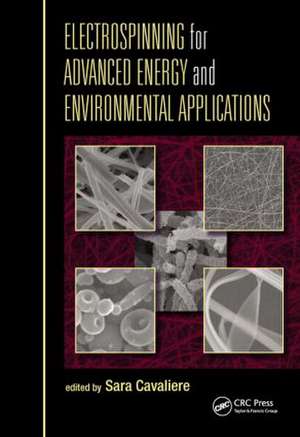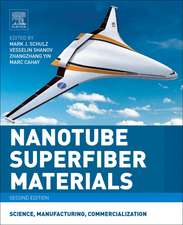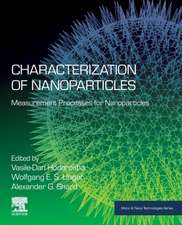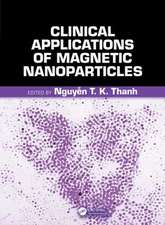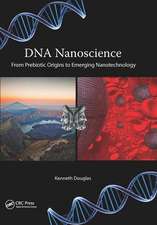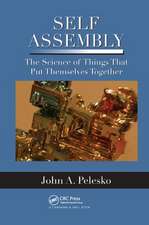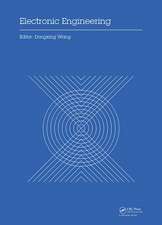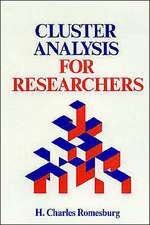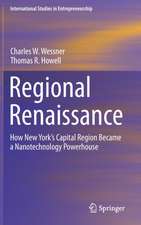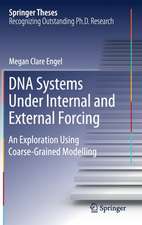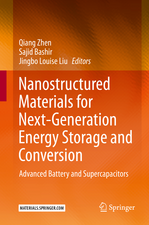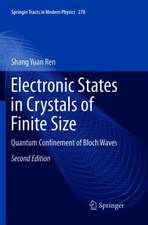Electrospinning for Advanced Energy and Environmental Applications
Editat de Sara Cavaliereen Limba Engleză Hardback – sep 2015
- Introduces the electrospinning technique and its origins, outlining achievable one-dimensional (1D) nanoscaled materials and their various applications
- Discusses the use of electrospun materials in energy devices, including low- and high-temperature fuel cells, hydrogen storage, dye-sensitized solar cells, lithium-ion batteries, and supercapacitors
- Explores environmental applications of electrospun fibers, such as the use of electrospinning-issued materials in membranes for water and air purification, as well as in sensors and biosensors for pollution control
| Toate formatele și edițiile | Preț | Express |
|---|---|---|
| Paperback (1) | 430.80 lei 6-8 săpt. | |
| CRC Press – 30 aug 2017 | 430.80 lei 6-8 săpt. | |
| Hardback (1) | 1103.10 lei 6-8 săpt. | |
| CRC Press – sep 2015 | 1103.10 lei 6-8 săpt. |
Preț: 1103.10 lei
Preț vechi: 1482.43 lei
-26% Nou
Puncte Express: 1655
Preț estimativ în valută:
211.09€ • 218.96$ • 176.01£
211.09€ • 218.96$ • 176.01£
Carte tipărită la comandă
Livrare economică 27 martie-10 aprilie
Preluare comenzi: 021 569.72.76
Specificații
ISBN-13: 9781482217674
ISBN-10: 1482217678
Pagini: 302
Ilustrații: 102 black & white illustrations, 23 colour illustrations, 10 black & white tables
Dimensiuni: 156 x 234 x 23 mm
Greutate: 0.73 kg
Ediția:1
Editura: CRC Press
Colecția CRC Press
ISBN-10: 1482217678
Pagini: 302
Ilustrații: 102 black & white illustrations, 23 colour illustrations, 10 black & white tables
Dimensiuni: 156 x 234 x 23 mm
Greutate: 0.73 kg
Ediția:1
Editura: CRC Press
Colecția CRC Press
Cuprins
Fundamentals of Electrospinning. Electrospun Nanofibers for Low-Temperature Proton Exchange Membrane Fuel Cells. Electrospinning for Solid Oxide Fuel Cells. Electrospun Materials for Hydrogen Storage. Electrospun Nanofibers for Supercapacitors. Electrospinning for the Development of Improved Lithium-Ion Battery Materials. Electrospinning Techniques and Electrospun Materials as Photoanodes for Dye-Sensitized Solar Cell Applications. Recent Developments of Electrospinning for Biosensors and Biocatalysis. Eco-Friendly Electrospun Membranes Made of Biodegradable Polymers for Wastewater Treatment. Electrospinning for Air Pollution Control.
Notă biografică
Dr. Sara Cavaliere has been assistant professor at the University of Montpellier in the Laboratory for Aggregates, Interfaces and Materials for Energy–Charles Gerhardt Institute for Molecular Chemistry and Materials since 2009. After graduating in chemistry from the University of Milan, Italy, she received her Ph.D. in chemistry and materials science in 2006 in Versailles, France. She carried out postdoctoral research work at the University of Freiburg, Germany, and the University of Lyon, France. In 2012, she was awarded an ERC starting grant (project SPINAM) on the use of electrospinning for the elaboration of integrated membrane-electrode assemblies for energy devices. Her research interests focus on the design and preparation of nanostructured and nanofibrous materials for energy conversion and storage applications.
Recenzii
"… a comprehensive view of the application areas of electrospun fibers in energy and environment. A timely, much-needed book on an important subject; a must read for all working in this field and application areas."
—Erich Kny, Chair of COST MP1206 on Electrospinning
—Erich Kny, Chair of COST MP1206 on Electrospinning
Descriere
This book delivers a state-of-the-art overview of the use of electrospun fibers in energy and environmental applications. It first introduces electrospinning and its origins, outlining achievable one-dimensional nanoscaled materials and their applications. It then discusses the use of electrospun materials in energy devices, including low- and high-temperature fuel cells, hydrogen storage, dye-sensitized solar cells, lithium-ion batteries, and supercapacitors. It also explores environmental applications, such as the use of electrospinning-issued materials in membranes for water and air purification, and in sensors and biosensors for pollution control.
